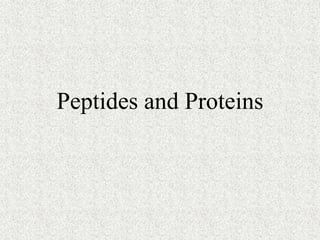
PeptidesandProteins.ppt
- 2. Peptide primary structure problem • An unknown octapeptide gives the following upon total hydrolysis: A(2), C, D, G, L, M, S • Reaction of the octapeptide with Sanger’s reagent followed by total hydrolysis gives “labeled” leucine (L). • Carboxypeptidase treatment of the octapeptide gives initially a high concentration of alanine (A), followed by glycine (G) and then serine (S). • Leucineaminopeptidase treatment of the octapeptide gives initially a high concentration of leucine (L), followed by aspartic acid (D) then cysteine (C). • Partial hydrolysis of the octapeptide gives the following identifiable fragments • D – C – M, A – S, C – M – A, S – G – A, and L – D • Write the correct primary structure (using one-letter abbreviations and following the usual convention of listing the N-terminal amino acid on the left). L A G S D C N-terminal aa C-terminal aa M A D – C – M C – M – A S – G – A A – S L – D
- 3. Classification (vague) • Peptides have fewer than 50 amino acids – Oligopeptides (di, tri-, tetra-, etc.) up to about 10 aa – Polypeptides (longer chain of aa than an oligopeptide) • Proteins have more than 50 amino acids, and may be combined with other structure classes, such as carbohydrates, lipids, etc. – Simple…yield only amino acids upon hydrolysis – Conjugated…yield amino acids and other structure types (carbohydrate, lipid, etc.) on hydrolysis
- 4. Levels of Protein Structure • Primary structure: the amino acid sequence • Secondary structure: the conformation due to rotations around C-C and C-N single bonds • Tertiary structure: the folding of the peptide chain into its characteristic 3D-shape • Quaternary structure: the aggregation of several subunits held together by other than covalent bonds (not all peptides have this feature)
- 5. Primary Structure • the amino acid sequence, written from the N- terminal (on the left) to the C-terminal (on the right). Formerly abbreviated using three-letter abbreviations: Ala, Gly, Phe, Val, etc.; now we use one-letter abbreviations: A, G, F, V. Ala – Gly – Phe – Val or A-G-F-V
- 6. Secondary Structure • the 3-D arrangement (conformation) of segments of a peptide/protein chain due to rotation around C-C and C-N bonds N H C O R H C O C H N
- 7. Secondary Structure • There are several named conformations due to common typical combinations of rotation angles around C-N () and C-C () bonds: – a-helix -58º -47º – b-pleated sheet ( -140º 135º – hairpin turns are sharp curves in the peptide chain, often due to proline residues )
- 8. Problem w/ flat sheet (F and = 180º)
- 9. b-pleated sheet 7.0 Å (F = -140º; = 135º) b-pleated sheet can be stabilized by H-bonding between adjacent peptide chains
- 10. a-helix (F = -58º; = -47º) a-helix is stabilized by H-bonding within a peptide chain
- 11. Tertiary and Quaternary Structure • Tertiary structure: the coiling or folding pattern of single polypeptide chains – Many individual shapes, but generally fall into one of two categories: • Fibrous (insoluble; generally function as structural component) • Globular (soluble; coiled into compact, spherical shapes, with hydrophobic groups oriented inward and hydrophilic groups oriented outward toward the aqueous environment of the cell) • Quaternary structure: non-covalent aggregation of two or more protein molecules and possibly other structures into functional units. (examples will be shown in WebLab Viewer Lite)
- 12. Functions of Proteins • Hemoglobin: the oxygen-carrying molecule in the blood • Insulin: regulates glucose metabolism • HIV protease: cleaves peptide bonds of large protein to allow activation of HIV virus within host cell • Carboxypeptidase: digestive enzyme that hydrolyzes peptides into their component amino acids • Keratin: provides structure of wool, hair, fingernails, and feathers